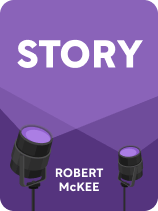

This article is an excerpt from the Shortform book guide to "Story" by Robert McKee. Shortform has the world's best summaries and analyses of books you should be reading.
Like this article? Sign up for a free trial here.
Why do people love stories? What’s story theory? What’s the difference between text and subtext?
In Robert McKee’s book Story: Substance, Structure, Style, and the Principles of Screenwriting, he discusses what makes a story good, the elements of a story, and how a story is structured. He also shares his recommended writing process.
Here’s our overview of McKee’s guide for screenwriters, which covers fundamental principles that apply to any kind of storytelling.
Overview of Story by Robert McKee
Stories are mysterious—like music, they have an emotional power over us that’s impossible to explain. However, screenwriter and storytelling expert Robert McKee argues that stories’ emotional power is not only explainable but also something you can learn to create. In Story: Substance, Structure, Style, and the Principles of Screenwriting, McKee breaks down how stories function and uses this theory to explain how you can write a gripping story.
McKee began teaching story in a class at the University of California and has since become one of the most sought-after lecturers on the topic of story.
We’ll begin by defining what characterizes a “good” story and explaining how a theoretical understanding of storytelling helps you write better stories. Then, we’ll dive into story theory, detailing the ingredients needed to write a meaningful story and intensify its emotional impact. Next, we’ll explain story structure, describing the pattern that all well-written stories follow. Finally, we’ll outline the ideal writing process, explaining the specific way to write an excellent story.
What Makes a Story “Good”?
McKee argues that we’re obsessed with stories because they fill a core human need: We need to find meaning, truth about the world that influences how we live our lives. When we encounter new meaning, it’s an intense, emotionally satisfying experience, and it’s a craving for this experience that motivates us to seek stories. The best stories are rich in meaning.
Since stories are meant to fill the human need for meaning, McKee asserts that good stories are always true to life. This doesn’t mean that good stories have to be something that could realistically occur—rather, every detail in a good story reflects life as it truly is. McKee explains that even stories that are totally detached from reality convey truth about life.
The Purpose of Story Theory
McKee argues that writers must learn story theory: what elements of a story make it meaningful and why. These aren’t rules dictating what you can and can’t write—rather, they’re an explanation of what elements in a story give the audience meaning and how they do so.
According to McKee, an understanding of story theory helps you write good stories in two ways. First, it clarifies the ideal writing process. When you have a process you can trust, you’re free to let your imagination run wild in the world of the story instead of constantly worrying about whether you’re “doing it right.” Second, story theory is necessary to understand how a story functions after you’ve written it. In this way, it helps you diagnose which parts of your story work and which you need to revise.
How Story Creates Emotion and Meaning
According to McKee, to engage an audience’s sense of meaning, a story needs three things.
Ingredient #1: An Active Protagonist to Empathize With
First, McKee asserts that the audience needs at least one protagonist to identify with. Additionally, this protagonist must constantly take action toward a goal, as this is necessary to engage the audience.
Ingredient #2: Constant Subversion of Expectation
The second main ingredient in story is the subversion of expectation. This ingredient is extremely important. McKee maintains that it’s the source of all energy in a story. The most basic unit of storytelling is this: The protagonist takes a single action toward a goal, and the world reacts in a way the protagonist doesn’t expect, complicating the protagonist’s plan to achieve their goal. This pair of action and reaction is called a beat.
How Subversion of Expectation Impacts the Audience
McKee asserts that beats of action and unexpected reaction need to occur constantly throughout your story because they engage your audience on both an intellectual and emotional level.
On an intellectual level, subversion of expectation piques the audience’s curiosity. For the majority of beats, the audience and protagonist both have their expectations subverted at the same time, says McKee.
McKee explains that subversion of expectation also engages the audience intellectually by giving them insight: They realize something about the protagonist’s world that they didn’t know before. This worldview revision satisfies the audience on an intellectual level—it feels like they’re solving the puzzle that the writer has laid for them.
On an emotional level, a beat of action and unexpected reaction impacts the audience because of their empathy for the protagonist, McKee explains. When something unexpected happens to the protagonist, they’ll have some kind of emotional reaction, and the audience will feel it just as they do.
Ingredient #3: Positive or Negative Change
Finally, the third main ingredient in an engaging story is positive or negative change. It’s not enough for a beat to be surprising, it also has to be meaningful. That is, it must feel like it reveals truth about life. When a protagonist’s action causes their life to change, the writer is saying “When someone does this, it will cause that to happen.” This is the story’s meaning.
With this in mind, McKee argues that every beat in your story must lead toward some kind of change—otherwise, the beat is meaningless.
McKee defines positive and negative change in terms of universal human values. These are states of being that you can gain or lose, such as love, safety, or social status. Value changes control your audience’s emotional response: Positive changes cause the audience to feel good for your protagonist, and negative changes cause them to feel bad for your protagonist.
Additionally, for a value change in your protagonist’s life to be meaningful, McKee explains that the change must occur because of your protagonist’s actions. A few random events that change your character’s life are fine to include in your story, but they don’t create meaning on their own.
Every Scene Ends With a Value Change
A series of beats in which a protagonist’s actions eventually cause one or more significant values to change is what McKee calls a scene. The scene is the smallest unit of storytelling that feels like a complete story.
How to Intensify Your Story’s Meaning
To increase the meaning and emotional impact of your story, McKee argues that you need to include two additional ingredients.
Intensifier #1: Escalating Risk
McKee explains that you must force your protagonist to risk losing what they care about most in the pursuit of a valuable goal. Why? In life, we judge how valuable something is by how much we’re willing to risk or sacrifice for it. Thus, creating a protagonist who’s willing to risk everything they care about is the most direct way to make an audience feel like the protagonist’s actions are important and meaningful.
Furthermore, the pacing at which you escalate risk in your story is important: To make a story continuously interesting, you must incrementally heighten your protagonist’s risk over the course of the story, explains McKee.
Story Beats Naturally Escalate Risk
McKee notes that the need for escalating risk is another reason why the beat is the basic unit of storytelling. When a protagonist’s action meets an unexpected reaction, it can escalate the risk of the protagonist’s actions in a believable way. After this happens enough times in a row, you’ll have believably built a story with high stakes.
Intensifier #2: Thematic Coherence
For a story to have the most meaningful impact possible on an audience, it must feel like every part of the story is conveying the same meaning. This meaning is your story’s theme, which McKee calls a “controlling idea.”
According to McKee, a theme is always a specific, truthful statement about the world that expresses cause and effect. This cause and effect will typically be the final value change of your story and the reason for that change.
All Value Changes Reflect Theme
McKee explains that, to create thematic coherence, every scene’s climactic value change should either prove the truth of your theme, or the opposite of your theme, which we’ll call the anti-theme.
Furthermore, McKee claims that your story should alternate between the two, so it seems to prove one idea, then its opposite, over and over until the climax, in which the theme definitively triumphs over the anti-theme. This uncertain tension between two contradictory ideas reflects the complexity of life in a far more believable, meaningful way than if you were to make every scene in your story prove the same point. This allows your story to convey a specific message without ever explicitly telling it to the audience.
How to Structure a Story
McKee argues that, because stories must include all these ingredients, all the most impactful stories follow a consistent pattern, or story structure.
The Key Parts of a Story: Climax and Inciting Incident
McKee argues that the most important scene in all stories is the climax: the final, most extreme, and irreversible change in your story. The climax is where the protagonist risks the most and either succeeds or fails to achieve their goal. Additionally, the climax definitively “proves” your theme.
To effectively create a meaningful climax, you also need to write a well-crafted inciting incident: a scene early in the story that creates the first major change in your protagonist’s life. This is the goal the protagonist will be chasing for the entire story, until the climax.
In short, your inciting incident raises the central question of your story, and the climax answers it. These two events form the core of your story.
Everything in Between: Scenes, Sequences, and Acts
McKee asserts that the parts of your story between the inciting incident and the climax also follow a consistent pattern. In a scene, a protagonist pursues a goal, hits an obstacle that subverts their expectations, and causes something in their life to change. To write a full story, repeat this pattern at a big-picture level.
Scenes build on one another to form a sequence. A series of sequences that leads to an extreme change is what McKee calls an act, and a very small handful of acts make up your whole story.
This design ensures that every single beat is contributing toward several consequential value changes: the next scene climax, sequence climax, and act climax. Therefore, every beat in every scene feels important, and your story’s beats feel progressively more important and meaningful as the sum of all your protagonist’s actions leads to bigger changes.
McKee asserts that feature films need to have at least three acts to have the most meaningful impact on an audience.
How to Write a Story
McKee details what he believes to be the ideal writing process: Begin with an outline, flesh it out into a treatment, then polish it into a final script.
Step #1: Create an Outline
McKee’s first step in writing a story is to create an outline: a detailed description of every one of your story beats and value changes. This outline is solely a description of plot and intentionally lacks dialogue or screenplay-style description. Since you’re essentially writing your entire story in outline form, this step will take up the majority of your time.
McKee recommends outlining many more scenes than you end up using. Select the very best and throw the rest away.
Keep writing compelling scenes, fleshing out the world of your story, until you find a climax that strikes you deeply on an emotional level. This climax will reveal to you what the theme of your story is: your story’s final change and the cause behind that change. Then, you can start building your story backward.
Once you have a complete story, McKee recommends pitching it to a friend. Keep fine-tuning your outline until you have a story that reliably delivers an emotional impact on your listeners.
How to Write Compelling Scenes
To create scenes that are true to life, you must create realistic beats. To do this, McKee recommends that you place your characters in a situation, then dive deep into your imagination to discover what you believe each character would authentically be thinking and feeling in that situation. Write down what action that character would honestly take.
Next, to make sure each beat advances your story, examine your scene objectively and imagine what could realistically happen that is the opposite of what your protagonist expects. Write this down, then return to the protagonist’s point of view and imagine their next move. Repeat until you reach a value change that marks the end of the scene. McKee asserts that this repeated oscillation between subjective and objective points of view is the key to writing compelling scenes.
Step #2: Write a Treatment
A treatment is a more detailed description of each scene. You not only write in extreme detail what happens in each scene but also what each character is thinking and feeling. This internal subtext will often contradict what the characters superficially appear to be doing. Write down both textual layers to ensure you fully understand what’s happening in your story in every scene.
Step #3: Finish Your Script
The last step in writing a story is to add dialogue, scene description, and everything else that will end up in the final product.
McKee notes that any one of these three steps may require extensive revision. McKee asserts that you must work up the courage to throw out anything that doesn’t work. After you’ve done this, you’ll be left with a powerful, well-written story.
Exercise: Analyze a Familiar Story
To better understand McKee’s story theory, analyze a story using the framework you’ve just learned.
- Pick a story you’re familiar with—this might be your favorite movie, a book you’ve just read, or a memorable play. Identify the story’s climax, then use that climax to identify the story’s theme. (For example, the climax of The Shawshank Redemption is the scene in which Andy Dufresne finishes his tunnel out of prison. Judging by this climax, the theme might be “When you work for a better future, eventually, you’ll be rewarded.”)
- Use the climax to help you identify the inciting incident that it resolves. What is your story’s inciting incident, and what goal does it establish? (For example, the inciting incident of The Shawshank Redemption is when Andy is falsely accused of murdering his wife and imprisoned at Shawshank. This event plunges Andy into a miserable life in prison, giving him the story goal to create a life worth living for himself and his fellow inmates.)
- List the story’s act climaxes: the scenes with the most significant changes. What extreme value changes occur in each of these scenes? (For example, the Act Two climax of The Shawshank Redemption is when the warden kills Tommy to prevent him from leaking evidence that proves Andy’s innocence. Negative value change: Andy loses a friend as well as the hope of being exonerated.)
- Pick one scene from the story and analyze it on the level of story beats. Describe several beats of the protagonist’s action and the world’s reaction, then identify the value change at the end of the scene. (For example, while tarring the roof of the prison, Andy stops working and offers to help a guard exploit a loophole in his taxes. The guard threatens to throw him off the roof. Andy talks the guard into accepting his deal in exchange for beers for his fellow prisoners. The guard agrees. Positive value change: Andy gains the admiration of the inmates.)

———End of Preview———
Like what you just read? Read the rest of the world's best book summary and analysis of Robert McKee's "Story" at Shortform.
Here's what you'll find in our full Story summary:
- A guide for screenwriters on how to write a gripping story
- How to engage an audience on an emotional and intellectual level
- The three-step process for how to write a story






